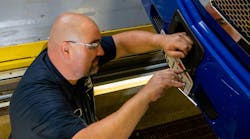This is Part Two of a two-part story. Read Part One here.
Like all other systems on a commercial vehicle, ADAS technologies must be properly maintained to operate effectively, or else risk detracting from their ability to increase both efficiency and safety on the road.
“Improperly maintained systems run the risk of being unavailable or not operating to their fullest capacity,” said Brian Screeton, manager, technical training & service at Bendix Commercial Vehicle Systems, maker of heavy-duty ADAS solution Wingman Fusion. “A system not performing to expectations can also contribute to driver frustration when behind the wheel, hindering acceptance of the technology."
To add to the complexity, ADAS work with several other systems on any given vehicle, whether its radar and cameras mounted on the windshield to integration with the electrical system. This means maintenance on those components can mean maintenance on driver safety systems, too. Here's some considerations to keep in mind when handling maintenance for the technology that helps keep drivers safe on the road.
Integrated system maintenance
“ADAS are built on the foundation of antilock braking systems (ABS) and electronic stability control (ESC) technologies,” Screeton added. “A fault with the ABS or ESC system means that the ADAS may not be available.”
One ABS concern that Screeton noted centers on wheel-speed sensors, which can be susceptible to chassis harness issues such as rubs and chafing, as well as issues occurring when service is done at the wheel-end. The sensor may then become nonfunctional if it’s not close enough to the tone ring or a wire is severed.
For stability control, an issue that Screeton advised may arise can be the steering angle sensor falling out of calibration. This can sometimes happen after an alignment, so it’s important to calibrate the sensor after any work is done on the front end.
Read more: Factoring in ADAS when repairing a cracked windshield
“Camera issues may tie to camera placement, blindness, or the chassis wiring harness,” Screeton related. “Radar issues can be caused by sensor misalignment, vehicle wiring, or active diagnostic trouble codes in other components of the vehicle, like the engine. All radar issues should be evaluated by a trained professional to ensure that the system is functioning properly.”
Chuck Brodie, fleet service engineer, commercial vehicle solutions at ZF Group, pointed out two other things a fleet maintenance operation should consider.
“First, ADAS rely heavily on the vehicle’s electrical and CAN systems,” he said. “Technicians with a strong background in those areas will have an easier time working on them. They will also need to be equipped with diagnostic software and system-specific maintenance manuals.”
Cameras and calibration
Many telematics and video systems can report data on ADAS performance to streamline repairs, Brodie also pointed out. Maintenance operations may find it worthwhile to use that data when addressing issues and specific driver concerns.
“When it comes to ADAS technologies, there are calibration and repair procedures which may be required when replacing components such as cameras or sensors,” said Connor McCann, ADAS strategy and planning director at Ford. “There are also important procedures for ADAS which may be required following collision repairs, windshield replacements, etc., to ensure proper system and feature performance.”
Jacob White, director of product marketing at Peterbilt Motors, also noted that ADAS technologies typically require a calibration process as part of repair procedures in the event of a collision to ensure the systems operate properly.
“ADAS relies on cameras and radar, which require regular checks and cleaning to ensure accurate functionality,” said Pedro Garcia, global head of product development at Nikola. “Dirt, snow, or even minor damage can impair their performance.
“Any repair or replacement, especially involving windshields, bumpers, or side skirts where sensors are located, typically requires recalibration of the ADAS,” Garcia added. “This is crucial for maintaining system accuracy.”
The time of year can make recalibrating more difficult.
“Winter weather can have a serious impact on the accuracy and precision of dynamic ADAS recalibrations,” Duane “Doc” Watson, technical trainer at Bosch Automotive Aftermarket, noted in an article on sibling brand VehicleServicePros.com. “Snowfall, ice, and accumulation on roads can all play major roles in visibility, vehicle stability and more.”
Watson advised that technicians monitor forecasts to determine the best time to drive the vehicle that requires calibration, as well as check that the tires are not overly worn or full of snow. That could cause slipping, which impacts accuracy. He added that cold weather can also diminish the accuracy of recalibration tools.
While these ADAS maintenance needs may sound intimidating, early adopters have found maintaining these systems to be relatively smooth.
“For the most part, these systems are fairly trouble-free,” said James Husted, director of maintenance at dry freight truckload carrier Garner Trucking in Findlay. “Any issues we had early on are gone, as the technologies have been upgraded and improved.”
Other than some early issues with ABS tone rings, which have been addressed, the main service needs for ADAS technologies at Garner are to make sure radar system covers are not cracked and to have cameras realigned if a windshield is replaced.
Ultimately, regardless of which ADAS a fleet chooses and how this technology improves over the years, road safety still lies with the driver.
“It’s always important to keep in mind that safety technologies complement safe driving practices,” said TJ Thomas, director of marketing and customer solutions—controls at Bendix. “No commercial vehicle safety technology replaces a skilled, alert driver exercising safe driving techniques. Responsibility for the safe operation of the vehicle always remains with the driver.”
But with a job as demanding as driving a truck, it’s nice to have a little backup from systems that are in peak condition.




